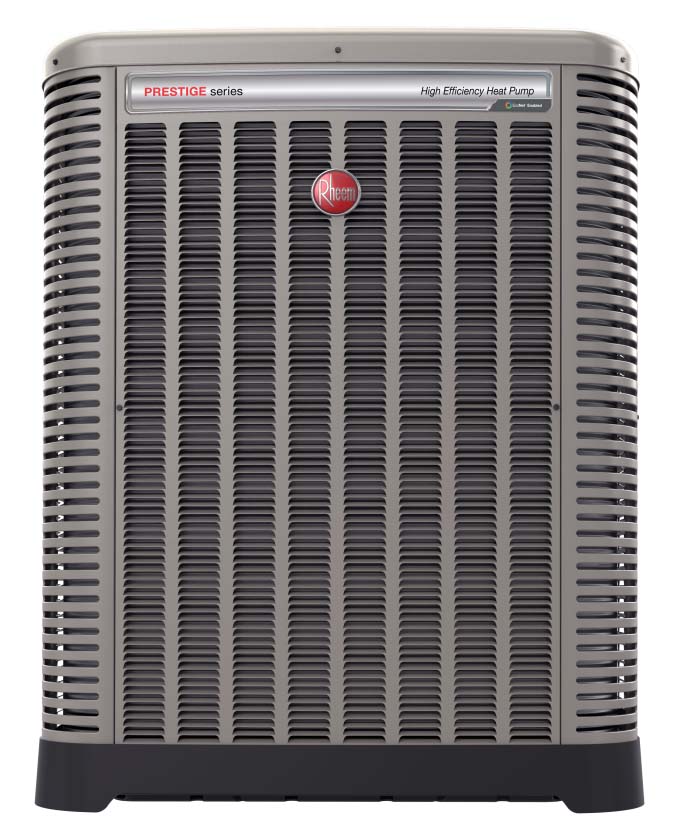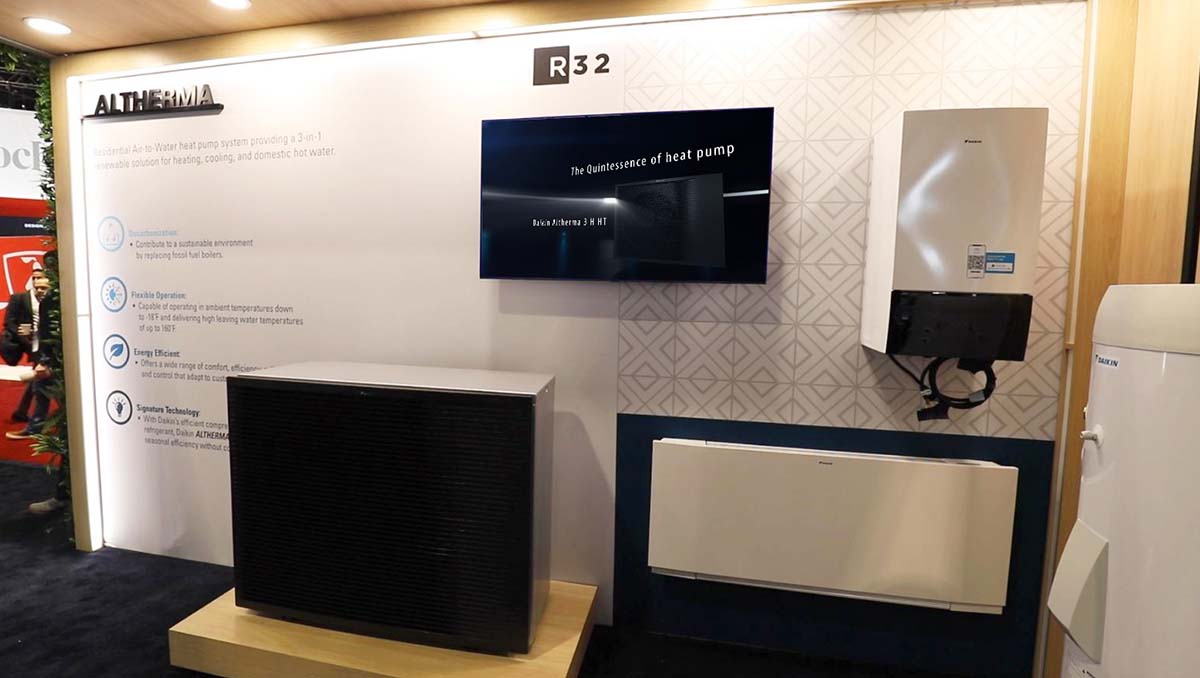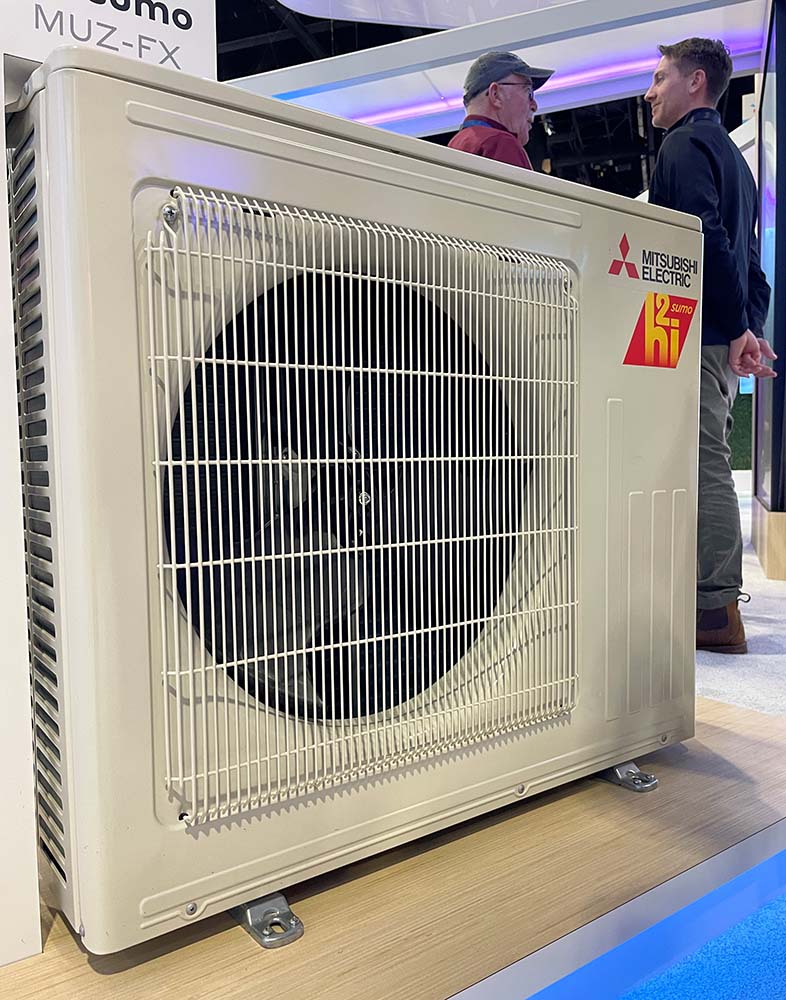Midea has a little secret about cold climate heat pumps.
“It’s all about the compressor.”
Speaking at a press conference at the AHR Expo, David Rames, senior product manager at Midea America Corp., outlined just how well that technology has played out for his company.
“In 2021, we came out with a full capacity, from 18,000 to 60,000 BTUs, that has 100% heating output at -4°F — so we can handle every climate in North America with our heat pump technology through the advancements of our compressor,” he related. “Then we advanced to the 2023 Department of Energy Cold Climate Heat Pump Challenge. And our result: 100% heating capacity at -15°F.”
Midea is one of 10 companies that signed up to participate in the DOE CCHP Challenge, one of four to make it to field trials — and one of many OEMs taking on the challenge in a more general sense. Manufacturers say the market is awash with possibilities for those who are willing to innovate.
director of product management, cooling
Lennox Residential HVAC
Opportunities Abound
Looking at the cold climate heat pump (CCHP) market in 2024, Chris North, program manager, residential product marketing, METUS, predicts “nothing but growth for us.”
“There are double-digit growth opportunities in the cold climate heat pump market over the next decade,” said Tim Brizendine, director of product management, cooling at Lennox Residential HVAC. Not only will new performance levels allow regions throughout North America to use heat pumps with confidence in low temperatures, he said, but with rising energy costs, these regions will have access to an energy-efficient solution that they can see reflected in their monthly energy bills.
Today, said Midea’s Rames, the heat pump market is being driven by government incentives and local utility rebates.
“Let’s face it — we need incentives; because of the technology, it will be more expensive,” he said. And while the Inflation Reduction Act (IRA) is huge, its incentives aren’t general knowledge yet. Neither, he asserted, are the capabilities of modern heat pumps.
“What we found out is contractors, and especially homeowners, have no idea we have this technology,” Rames said. “If you come in and you offer a heat pump, and they go, ‘Oh, my grandpa had a heat pump and he said he hated it — it blew cold air at 40°, it got cold in the house,’ that is our opportunity to say, ‘Grandpa's technology is no more. This is futuristic, this is innovative, you have to trust us — we can handle all geographic geographical areas, and we can give you the heat that you need.’”
Rames shared some data from Midea’s consumer research that underscores the confusion in the marketplace. When asked what a heat pump is, 80% of homeowners said yes, and 50% said they knew what it could do. Then, they were asked if they knew modern heat pumps could handle 100% of the heating load at -4°F.
“Four percent said ‘I knew’; that means 96% had no idea,” Rames said. “Thirty percent of contractors knew. But contractors are supposed to be the experts.”
Moving on to federal tax credits, 53% of homeowners weren’t aware they could get up to $2,000 to offset the increase in price of going from an a/c to a heat pump. However, after some education on the performance and cost savings of modern heat pumps, 82% of homeowners said they’d be more willing to make the switch.
“It's all about education,” he concluded. “So as a manufacturer, we have taken it upon ourselves to be the educators, because even though consumers are more educated than ever, they still don't know certain things. The manufacturer has got to do the educating from the top down. We're going to start educating, educating, educating so that a consumer will be able to make this transition.”
Jeff Goss, director of residential product management at Rheem, agrees on the education aspect.
“We find that contractors install what they are comfortable with, so we need to continue to train contractors on heat pump technology,” he said. “It’s also worth noting, HVAC contractors are pivotal in guiding customers on new technologies, as they are the ones providing valuable information on technologies contributing to decarbonization and highlighting the latest advancements in energy-efficient HVAC products.”
The cold climate aspect of heat pump technology, said Mike Smith, senior manager of marketing and communications at METUS, will pick up awareness as more CCHPs get operational in the field.
“We’ve already seen heat pumps outpace furnace sales in 2022,” he noted. “When we go on our social media channels, we're seeing tons of really positive testimonies. And some engineer types are even saying they’ve got their infrared gun and are shooting the unit and air discharge, taking the temperature.”
And J. Kelly Hearnsberger, vice president at Daikin Comfort Technologies North America Inc., points to the company’s cold-climate mini splits as an example of what lies ahead for CCHPs.
“They've been well accepted and adopted in Northeast, Northwest, Midwest, Canada, multiple regions where there's a desperate need for high heat output,” he said. “And because we've seen the acceptance of those cold climate mini splits, we know that a whole-home ducted system would be accepted very well.”
Latest Offerings
Heat pumps are important enough to the federal government that as part of the Biden administration’s Investing in America agenda, DOE has budgeted $169 million for projects designed to accelerate their manufacture at 15 sites across the country. That’s in addition to the CCHP Challenge, now in its final stretch. Those new models haven’t yet been unveiled, but plenty of other cold-climate heat pumps continue to come out in the meantime.
Lennox, the first OEM to meet the DOE challenge requirements in the laboratory, is completing its second heating season in the field trial portion of the CCHP challenge. Brizendine reported the units have operated as expected and received positive feedback from the participants.
Lennox’s latest heat pump offering is the SL25XPV heat pump, which was designated as one of the Most Efficient Energy Star-certified products and boasts an efficiency rating of up to 24 SEER and up to 11.8 HSPF. The unit also features TruHeat Performance, which “delivers a greater amount of heat than traditional heat pumps for rich, warm comfort similar to a gas furnace — even during the coldest outdoor temperatures,” he said.
“Some dealers and homeowners are still hesitant about heat pumps in colder climates and fear that they will not perform,” Brizendine said. “We feel confident as more of our cold climate heat pumps are installed, consumers and dealers will see the groundbreaking technology works in temperatures as low as -15°F.”
Midea, for its part, did its CCHP Challenge lab test for heating capacity at -5°F — plus the optional test No. 2, which measured efficiency at -15° — and “crushed it, no problem,” Rames said.
“This product will be out later,” he said. “We still have to do some field installs, which we're in the middle of doing now; it's in very cold climates.”
Midea’s technology for its cold-climate offerings, Rames emphasized, is all about the compressor.
“We'll call it a compressor with a turbocharger on it,” he said, setting up an automotive analogy. “If I'm commuting in my car from and to work, no problem. If I'm pulling my boat, the turbochargers kick in. Our compressor, to put it in layman's terms, has a turbocharge if I need it … that kicks in and will give you the heat you need at those low, low, low temperatures.”
The company is also working to bring heat pumps to multifamily housing in cold climates. The Midea Packaged Window Heat Pump, a saddle-shaped, window-mounted, cold-climate packaged heat pump designed specifically for multifamily applications, won a 2024 AHR Innovation Award in the sustainable solutions category. It was originally developed as part of the “Clean Heat for All Challenge,” a public-private initiative to bring cold-climate packaged heat pumps to New York housing developments.
“It’s able to get 21.8 on SEER2 and 11.6 on HSPF2, which is just phenomenal, especially on a packaged unit,” said David Leezer, retail a/c R&D team leader at Midea America Corp. “We can do 100% heating at 5°F, and then heating functionality all the way down to -30°.” The unit has a self-contained condensate system, so nothing drips, nothing freezes, and no plumbing is required for the condensation.
Rheem’s CCHP prototype outperformed the DOE challenge criteria by running safely down to -23°F when tested at a third-party lab. The company is getting ready to launch its newest heat pump offering — the Rheem Endeavor Line Classic Plus Series Universal Heat Pump (RD17AZ). Soon available to order, the Energy Star-certified 2024 Most Efficient and Cold Climate RD17AZ offers a flexible installation option working with nearly any heating and cooling system option, including EcoNet-enabled and non-communicating systems, or as a universal replacement with minimal alterations required. It’s highly efficient (19 SEER2/ 12 EER2 / 8.5 HSPF2) and has a 7mm condenser coil, which reduces refrigerant requirements up to 15%.

OVERDRIVE: Rheem’s RP18AZ cold climate certified heat pump promotes ideal cooling operation between 40% and 100% of capacity, with overdrive capability up to 115% in extreme conditions. (Courtesy of Rheem)
Already available is the Energy Star certified Cold Climate, EcoNet Enabled Rheem Endeavor Line Prestige Series RP18AZ Heat Pump (5-ton). The inverter-driven and variable-speed compressor technology promotes ideal cooling operation between 40% and 100% of capacity, with an overdrive capability up to 115% in extreme conditions.
Daikin is in the process of launching its new air-to-water heat pump, Altherma, a system that’s been in production for over 15 years in Europe. Hearnsberger called it a hydro split; all the refrigerant is contained in the outdoor unit.
“It will accomplish space heating, space cooling, and domestic hot water all with one outdoor unit,” Hearnsberger said. “Basically, we're able to go into any market and replace three systems with one.

3 IN 1: Daikin’s Altherma will accomplish space heating, space cooling, and domestic hot water all with one outdoor unit. (Courtesy of Daikin)
“That's where I see the future of heat pumps going, where we just don't rely at all on any fossil fuel,” he continued. “Now, this has some electric resistance backup heat in it, because it's used in very northern climates — northern Sweden, Switzerland, very high altitude conditions. But we've had this system running in a field trial in a very, very, very northern climate. In fact, this morning, I checked on our system there: -16°, heat pump is operating just fine.”
Meanwhile, METUS is planning a 2024 launch for its latest H2i Hyper-Heating model.

SUMO: The HyperHeat Sumo by METUS will provide 100% heating at -10°F and guaranteed operation down to -22°. (Staff photo)
“We currently have Hyper-Heat, Hyper-Heat Plus, and this new model is going to be Hyper-Heat Sumo,” said Smith. “Hyper-Heat gives you 100% heating capacity in your outdoor unit to 5°. Hyper-Heat Plus takes it down to -5°, and Hyper-Heat Sumo drops it down even further, to 100% heating at -10°, guaranteed operation down to -22°. The previous version of it was guaranteed to -13°. It just essentially lowers the temperature as much as we can possibly do at the moment.”
METUS’ latest CCHP will include Bluefin coating on the outdoor unit to help resist corrosion, Dual Barrier Coating built into the indoor unit, and includes the 3D i-See Sensor, which can scan the room and adjust temperatures and airflow patterns in response to occupancy.



Report Abusive Comment